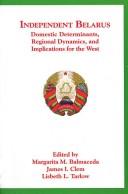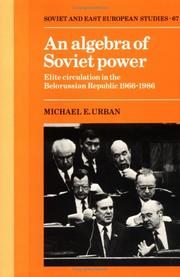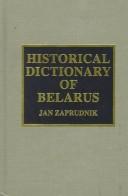| Listing 1 - 10 of 21 | << page >> |
Sort by
|

ISBN: 0916458946 Year: 2002 Publisher: Cambridge (Mass.) Harvard university press
Abstract | Keywords | Export | Availability | Bookmark
 Loading...
Loading...Choose an application
- Reference Manager
- EndNote
- RefWorks (Direct export to RefWorks)
#SBIB:328H263 --- Instellingen en beleid: andere GOS-staten --- Belarus --- -Belarus --- -Politics and government --- -Foreign relations --- -Republic of Belarus --- Rėspublika Belarusʹ --- Republic of Byelarusʹ --- Respublika Byelarusʹ --- Byelarus --- République de Bélarus --- República de Belarús --- Republik Belarus --- Weissrussland --- White Russia --- Belorussia --- Belorus --- Biélorussie --- Bielorussia --- Białoruś --- Politics and government --- Foreign relations.
Book
ISBN: 1280008997 9786610008995 0585228604 Year: 1997 Publisher: Washington, D.C. : World Bank,
Abstract | Keywords | Export | Availability | Bookmark
 Loading...
Loading...Choose an application
- Reference Manager
- EndNote
- RefWorks (Direct export to RefWorks)
Economic stabilization --- Economic History --- Business & Economics --- Adjustment, Economic --- Business stabilization --- Economic adjustment --- Stabilization, Economic --- Economic policy --- Belarus --- Republic of Belarus --- Rėspublika Belarusʹ --- Republic of Byelarusʹ --- Respublika Byelarusʹ --- Byelarus --- République de Bélarus --- República de Belarús --- Republik Belarus --- Weissrussland --- White Russia --- Belorussia --- Belorus --- Biélorussie --- Bielorussia --- Białoruś --- Беларусь --- Рэспубліка Беларусь --- Республика Беларусь --- ベラルーシ --- Berarūshi --- Byelorussian S.S.R. --- Economic conditions
Periodical
ISSN: 20526512 Year: 1965 Publisher: London [Anglo-Byelorussian Society]
Abstract | Keywords | Export | Availability | Bookmark
 Loading...
Loading...Choose an application
- Reference Manager
- EndNote
- RefWorks (Direct export to RefWorks)
Belarusian philology --- Belarusian philology. --- Byelorussian philology --- White Russian philology --- Belarus --- Belarus. --- Belorus --- Belorussia --- Berarūshi --- Białoru --- Bielorussia --- Biélorussie --- Byelarus --- Byelorussian S.S.R. --- Republic of Belarus --- Republic of Byelarusʹ --- República de Belarús --- Republik Belarus --- République de Bélarus --- Rėspublika Belarusʹ --- Respublika Byelarusʹ --- Weissrussland --- White Russia --- Białoruś --- Беларусь --- Рэспубліка Беларусь --- Республика Беларусь --- ベラルーシ --- 18.60 Slavic languages: other. --- 15.70 history of Europe. --- 74.19 geography of Europe. --- History.
Book
ISBN: 9633860261 9789633860267 9789633860250 9633860253 Year: 2014 Publisher: Budapest, Hungary ; New York, New York : Central European University Press,
Abstract | Keywords | Export | Availability | Bookmark
 Loading...
Loading...Choose an application
- Reference Manager
- EndNote
- RefWorks (Direct export to RefWorks)
Jewish life in Belarus after World War II was an inaccessible subject - officially regarded as being completely non-existent - and in the ideological atmosphere of the time research into the subject was impossible. Jewish community life had been wiped out by the Nazis, and its unreasonable attempt to come back to life was given short shrift by the communists. For more than half a century the truth about Jewish life during this period was sealed in archives to which researchers had no access. The Jews of Belarus preferred to keep silent rather than expose themselves to the spleen of the authorities. Although the fate of Belarusian Jews before and during the war has lately been amply studied, this book is one of the first attempts to study Jewish life in Belarus during the last decade of Stalin's rule. In addition to archival materials, the present research is based on data collected from a questionnaire submitted to Jews who had been residents of Belarus and are now citizens of Israel, as well as information from periodicals, collections of documents, statistical reports and monographs.
Jews --- Hebrews --- Israelites --- Jewish people --- Jewry --- Judaic people --- Judaists --- Ethnology --- Religious adherents --- Semites --- Judaism --- History --- Soviet Union --- Belarus --- Republic of Belarus --- Rėspublika Belarusʹ --- Republic of Byelarusʹ --- Respublika Byelarusʹ --- Byelarus --- République de Bélarus --- República de Belarús --- Republik Belarus --- Weissrussland --- White Russia --- Belorussia --- Belorus --- Biélorussie --- Bielorussia --- Białoruś --- Беларусь --- Рэспубліка Беларусь --- Республика Беларусь --- ベラルーシ --- Berarūshi --- Byelorussian S.S.R. --- Politics and government --- Ethnic relations. --- E-books --- Belarus, Ethnic relations, History, Jewish studies, Jews, Political studies, Religion, Soviet Union.
Book
ISBN: 0822979586 9780822979586 9780822963080 0822963086 Year: 2014 Publisher: Pittsburgh, Pennsylvania : University of Pittsburgh Press,
Abstract | Keywords | Export | Availability | Bookmark
 Loading...
Loading...Choose an application
- Reference Manager
- EndNote
- RefWorks (Direct export to RefWorks)
"Modern Belarusian nationalism emerged in the early twentieth century during a dramatic period that included a mass exodus, multiple occupations, seven years of warfare, and the partition of the Belarusian lands. In this original history, Per Anders Rudling traces the evolution of modern Belarusian nationalism from its origins in late imperial Russia to the early 1930s. The revolution of 1905 opened a window of opportunity, and debates swirled around definitions of ethnic, racial, or cultural belonging. By March of 1918, a small group of nationalists had declared the formation of a Belarusian People's Republic (BNR), with territories based on ethnographic claims. Less than a year later, the Soviets claimed roughly the same area for a Belarusian Soviet Socialist Republic (BSSR). Belarusian statehood was declared no less than six times between 1918 and 1920. In 1921, the treaty of Riga officially divided the Belarusian lands between Poland and the Soviet Union. Polish authorities subjected Western Belarus to policies of assimilation, alienating much of the population. At the same time, the Soviet establishment of Belarusian-language cultural and educational institutions in Eastern Belarus stimulated national activism in Western Belarus. Sporadic partisan warfare against Polish authorities occurred until the mid-1920s, with Lithuanian and Soviet support. On both sides of the border, Belarusian activists engaged in a process of mythmaking and national mobilization. By 1926, Belarusian political activism had peaked, but then waned when coups d'etats brought authoritarian rule to Poland and Lithuania. The year 1927 saw a crackdown on the Western Belarusian national movement, and in Eastern Belarus, Stalin's consolidation of power led to a brutal transformation of society and the uprooting of Belarusian national communists. As a small group of elites, Belarusian nationalists had been dependent on German, Lithuanian, Polish, and Soviet sponsors since 1915. The geopolitical rivalry provided opportunities, but also liabilities. After 1926, maneuvering this complex and progressively hostile landscape became difficult. Support from Kaunas and Moscow for the Western Belarusian nationalists attracted the interest of the Polish authorities, and the increasingly autonomous republican institutions in Minsk became a concern for the central government in the Kremlin. As Rudling shows, Belarus was a historic battleground that served as a political tool, borderland, and buffer zone between greater powers. Nationalism arrived late, was limited to a relatively small elite, and was suppressed in its early stages. The tumultuous process, however, established the idea of Belarusian statehood, left behind a modern foundation myth, and bequeathed the institutional framework of a proto-state, all of which resurfaced as building blocks for national consolidation when Belarus gained independence in 1991"--
Nationalism --- Consciousness, National --- Identity, National --- National consciousness --- National identity --- International relations --- Patriotism --- Political science --- Autonomy and independence movements --- Internationalism --- Political messianism --- History --- Belarus --- Republic of Belarus --- Rėspublika Belarusʹ --- Republic of Byelarusʹ --- Respublika Byelarusʹ --- Byelarus --- République de Bélarus --- República de Belarús --- Republik Belarus --- Weissrussland --- White Russia --- Belorussia --- Belorus --- Biélorussie --- Bielorussia --- Białoruś --- Беларусь --- Рэспубліка Беларусь --- Республика Беларусь --- ベラルーシ --- Berarūshi --- Byelorussian S.S.R. --- Autonomy and independence movements. --- Politics and government
Book
ISBN: 9780253024633 0253024633 9780253024510 0253024668 9780253024664 Year: 2017 Publisher: Bloomington
Abstract | Keywords | Export | Availability | Bookmark
 Loading...
Loading...Choose an application
- Reference Manager
- EndNote
- RefWorks (Direct export to RefWorks)
Nationalism and communism --- Jewish communists --- Jews --- Hebrews --- Israelites --- Jewish people --- Jewry --- Judaic people --- Judaists --- Ethnology --- Religious adherents --- Semites --- Judaism --- Communism and nationalism --- Communism --- Communists --- Economic conditions --- Social conditions --- History --- Belarus --- Republic of Belarus --- Rėspublika Belarusʹ --- Republic of Byelarusʹ --- Respublika Byelarusʹ --- Byelarus --- République de Bélarus --- República de Belarús --- Republik Belarus --- Weissrussland --- White Russia --- Belorussia --- Belorus --- Biélorussie --- Bielorussia --- Białoruś --- Беларусь --- Рэспубліка Беларусь --- Республика Беларусь --- ベラルーシ --- Berarūshi --- Byelorussian S.S.R. --- Ethnic relations.

ISBN: 0521372569 0521054885 0511598890 Year: 1989 Publisher: Cambridge : Cambridge University Press,
Abstract | Keywords | Export | Availability | Bookmark
 Loading...
Loading...Choose an application
- Reference Manager
- EndNote
- RefWorks (Direct export to RefWorks)
Control of office has long been regarded as the key element in understanding power and policy in the Soviet system. What, however, accounts for the control of office and how are individuals recruited into positions of power and responsibility? In An Algebra of Soviet Power, Michael Urban adopts a fresh approach and introduces into the field of political elite studies the sociological technique of vacancy chain analysis. This treats the movements of actors as sequences of complex inter-relations that are structured by the properties and powers of the personnel system rather than by the consequences of individual intentions or characteristics. This algebraic method is applied to a large body of career data of officials from the Soviet Republic of Belorussia for the period 1966-86. The author documents how, despite the formal systems of nomenklatura - central control over personnel placement - the flow of individuals through the hierarchy of offices in Belorussia has not been influenced by any coordinating policy issuing from Moscow or Minsk. Instead regionalism has played an important, and patronage the decisive, role in the system.
Elite (Social sciences) --- Social mobility --- Social Sciences --- Political Science --- Belarus --- Officials and employees. --- Politics and government. --- Mobility, Social --- Sociology --- Elites (Social sciences) --- Leadership --- Power (Social sciences) --- Social classes --- Social groups --- Republic of Belarus --- Rėspublika Belarusʹ --- Republic of Byelarusʹ --- Respublika Byelarusʹ --- Byelarus --- République de Bélarus --- República de Belarús --- Republik Belarus --- Weissrussland --- White Russia --- Belorussia --- Belorus --- Biélorussie --- Bielorussia --- Białoruś --- Беларусь --- Рэспубліка Беларусь --- Республика Беларусь --- ベラルーシ --- Berarūshi --- Byelorussian S.S.R.
Periodical
ISSN: 19495382 Year: 2007 Publisher: Washington, D.C. : U.S. Agency for International Development
Abstract | Keywords | Export | Availability | Bookmark
 Loading...
Loading...Choose an application
- Reference Manager
- EndNote
- RefWorks (Direct export to RefWorks)
Economic assistance --- Economic assistance. --- USAID/Belarus --- Belarus --- Belarus. --- Economic aid --- Foreign aid program --- Foreign assistance --- Grants-in-aid, International --- International economic assistance --- International grants-in-aid --- Economic policy --- International economic relations --- Conditionality (International relations) --- United States. --- Belorus --- Belorussia --- Berarūshi --- Białoru --- Bielorussia --- Biélorussie --- Byelarus --- Byelorussian S.S.R. --- Republic of Belarus --- Republic of Byelarusʹ --- República de Belarús --- Republik Belarus --- République de Bélarus --- Rėspublika Belarusʹ --- Respublika Byelarusʹ --- Weissrussland --- White Russia --- Białoruś --- Беларусь --- Рэспубліка Беларусь --- Республика Беларусь --- ベラルーシ

Abstract | Keywords | Export | Availability | Bookmark
 Loading...
Loading...Choose an application
- Reference Manager
- EndNote
- RefWorks (Direct export to RefWorks)
908 <476> --- 947 --- Heemkunde. Area studies--Wit-Rusland --- Geschiedenis van de Slavische wereld, van Rusland en de USSR --- 947 Geschiedenis van de Slavische wereld, van Rusland en de USSR --- 908 <476> Heemkunde. Area studies--Wit-Rusland --- Belarus --- Republic of Belarus --- Rėspublika Belarusʹ --- Republic of Byelarusʹ --- Respublika Byelarusʹ --- Byelarus --- République de Bélarus --- República de Belarús --- Republik Belarus --- Weissrussland --- White Russia --- Belorussia --- Belorus --- Biélorussie --- Bielorussia --- Białoruś --- Беларусь --- Рэспубліка Беларусь --- Республика Беларусь --- ベラルーシ --- Berarūshi --- Byelorussian S.S.R. --- History --- Dictionaries. --- Dictionaries --- 947 History of Russia --- History of Russia
Book
ISBN: 1484389301 Year: 2018 Publisher: Washington, D.C. : International Monetary Fund,
Abstract | Keywords | Export | Availability | Bookmark
 Loading...
Loading...Choose an application
- Reference Manager
- EndNote
- RefWorks (Direct export to RefWorks)
Belarusian authorities contemplate transiting to inflation targeting. The paper suggests a small structural model at the core of the forecasting and policy analysis system. A well-researched canonical structure of Berg, A., Karam, P. and D. Laxton (2006) is extended to capture specifics of Belarusian economy and macroeconomic policy. The modified model’s policy block reflects a monetary targeting regime and allows for transition from it to an interest-rate-based framework. Adding wages, directed lending and dollarization allow for studying implications of activist wage policy, state program lending, and dollarization for macroeconomic stability and the strength of the policy transmission mechanism.
Belarus --- Republic of Belarus --- Rėspublika Belarusʹ --- Republic of Byelarusʹ --- Respublika Byelarusʹ --- Byelarus --- République de Bélarus --- República de Belarús --- Republik Belarus --- Weissrussland --- White Russia --- Belorussia --- Belorus --- Biélorussie --- Bielorussia --- Białoruś --- Беларусь --- Рэспубліка Беларусь --- Республика Беларусь --- ベラルーシ --- Berarūshi --- Byelorussian S.S.R. --- Economic conditions --- Foreign Exchange --- Inflation --- Money and Monetary Policy --- Production and Operations Management --- Money and Interest Rates: Forecasting and Simulation --- Monetary Policy --- Quantitative Policy Modeling --- Price Level --- Deflation --- Macroeconomics: Production --- Demand for Money --- Macroeconomics --- Monetary economics --- Currency --- Foreign exchange --- Exchange rates --- Inflation targeting --- Output gap --- Demand for money --- Prices --- Monetary policy --- Production --- Money --- Economic theory --- Belarus, Republic of
| Listing 1 - 10 of 21 | << page >> |
Sort by
|

 Search
Search Feedback
Feedback About
About Help
Help News
News